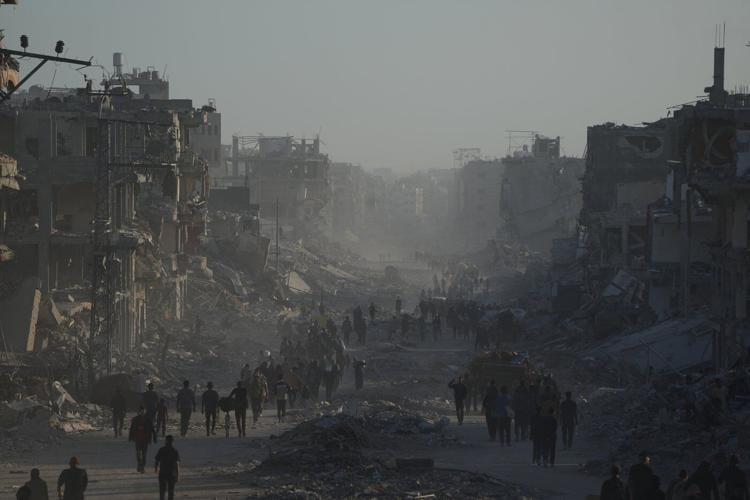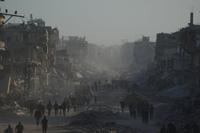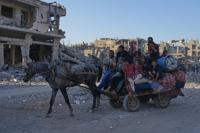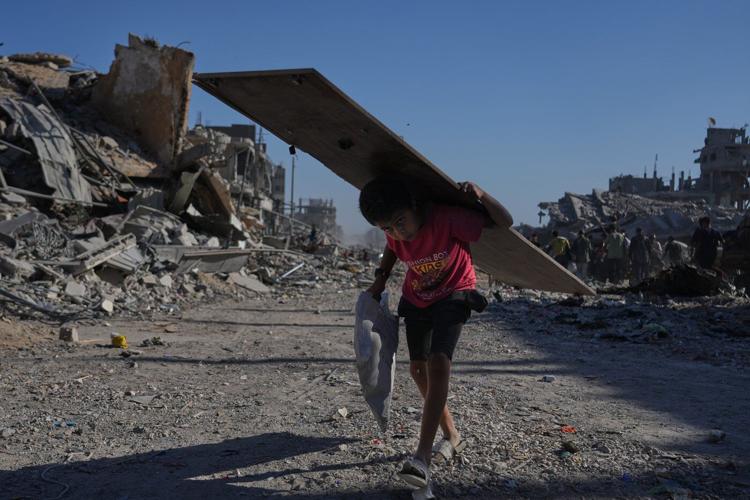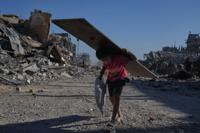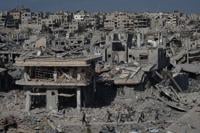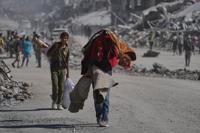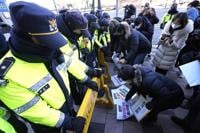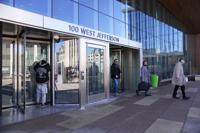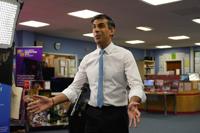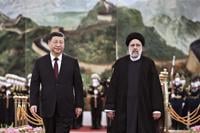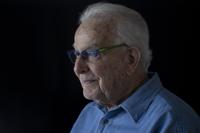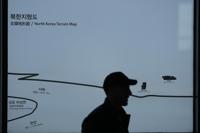GAZA CITY, Gaza Strip (AP) — Tens of thousands of displaced Palestinians loaded cars, carts and bicycles with belongings and made their way back to their neighborhoods on Saturday, weaving through streets shrouded in dust as bulldozers began to claw through the wreckage of two years of bombardment.
Aid groups were preparing to scale up relief work, one of the many challenges ahead as entered its second day.
“When people get there, they’re going to find rubble. They’ll find that their homes and their neighborhoods have been reduced to dust,” UNICEF spokesperson Tess Ingram told The Associated Press on Friday.
As the ceasefire appears to hold, her organization and its partners are urging Israel to reopen more crossings and allow aid to flow into Gaza more freely. Meanwhile, about 200 U.S. troops arrived in Israel to help retrieve hostages and monitor the ceasefire.
“A ceasefire alone is not enough,” Ingram said, speaking from central Gaza. “Yes, it stops the killing and injuring of children, hopefully, but it also needs to ensure a surge of humanitarian aid that begins to address the tremendous damage that has been done over the past two years.”
COGAT, the Israeli military body in charge of humanitarian aid, said that more than 500 trucks entered Gaza on Friday, although many crossings remain closed. With a declared famine still underway in parts of the strip, UNICEF has 1,300 trucks ready to enter, with more on the way, Ingram said.
The aid is among the 170,000 metric tons that have been positioned in neighboring countries awaiting permission from Israel to restart deliveries that have been suspended.
The days since the announcement of the ceasefire have moved swiftly. Israel’s military confirmed it had taken effect Friday and said the 48 hostages still in Gaza would be freed Monday. A U.N. official, speaking on condition of anonymity to discuss details not yet public, said Israel also approved expanded aid deliveries starting Sunday.
The steps mark key steps toward ending the ignited by Hamas’ Oct. 7, 2023, . The fighting has killed tens of thousands of Palestinians, flattened entire neighborhoods, and displaced around 90% of Gaza’s more than 2 million people, some multiple times.
Israel braces for hostages’ return
Across the border, Israel braced for the long-awaited return of hostages kept captive for more than two years.
“It’s been a few nights that we can’t sleep. We want them back and we feel that everything is just hanging on a thread,” Maayan Eliasi, a resident of Tel Aviv, said at a gathering at the city’s hostage square. “I can’t heal. None of us can.”
The government believes around 20 of the 48 hostages thought to be in Gaza remain alive.
over who will govern Gaza as Israeli troops gradually pull back and whether Hamas will disarm, as called for in the agreement. Prime Minister Benjamin Netanyahu, who unilaterally ended a truce in March, has suggested Israel could resume its offensive if Hamas fails to disarm.
“If it’s achieved the easy way — so be it. If not — to will be achieved the hard way,” he said Friday, pledging that the next stage would bring Hamas’s disarmament.
In Gaza, relief, reckoning and a new security order
The scale of destruction will likely become clearer as Israel’s military withdraws to ceasefire lines, but more than three out of every four buildings have been destroyed, the U.N. said in September, creating a volume of debris equivalent to 25 Eiffel Towers, much of it likely toxic.
A February assessment by the European Union and World Bank estimated $49 billion in damage, including $16 billion to housing and $6.3 billion to the health sector.
The death toll is expected to rise as more bodies that couldn't be retrieved during Israel's offensive are found.
A manager at northern Gaza’s Shifa Hospital told AP that 45 bodies pulled from the rubble in Gaza City had arrived over the past 24 hours. The manager, speaking on condition of anonymity for safety reasons, said the bodies had been missing for several days to two weeks.
New security arrangements are taking shape on the ground.
�հ��ܳ���’s calls for Israel to maintain an open-ended military presence inside Gaza, along its border with Israel. An international force, comprised largely of troops from Arab and Muslim countries, would be responsible for security inside Gaza, though the timeline is unclear.
The Israeli military has said it will continue to operate defensively from the roughly 50% of Gaza it still controls after pulling back to agreed-upon lines.
U.S. envoy Steve Witkoff told Israeli officials on Friday that the U.S. would establish a center in Israel to coordinate issues concerning Gaza until there is a permanent government, according to a readout of the meeting by a person who attended it and obtained by AP. Another official who was not authorized to speak to the media confirmed the contents of the readout.
The readout said no U.S. soldiers will be on the ground in Gaza, but there will be people who report to the U.S. and aircraft might operate over the strip for monitoring.
A different official who also spoke on condition of anonymity because they were not authorized to speak to the media said that a group — including the U.S, Qatar, Egypt and other countries and organizations — would be part of a mission to locate and identify hostage bodies and avoid previous issues with body misidentification. It was unclear if the 200 U.S troops coming to Israel would be part of that group or a separate initiative.
The war began when on Oct. 7, 2023, killing some 1,200 people and taking 251 hostage.
In Israel’s ensuing offensive, more than 67,000 Palestinians have been killed in Gaza and nearly 170,000 wounded, according to Gaza’s Health Ministry, which doesn’t differentiate between civilians and combatants but says around half the deaths were women and children. The ministry is part of the Hamas-run government, and the United Nations and many independent experts consider its figures to be the most reliable estimate of wartime casualties.
The war has also triggered other conflicts in the region, sparked worldwide protests and led to that Israel denies.
___
Metz reported from Jerusalem, El Deeb from Beirut, Lebanon and Mednick from Tel Aviv, Israel. Associated Press writer Sally Abou AlJoud in Beirut, Lebanon contributed to this report.
___
Follow AP’s war coverage at

